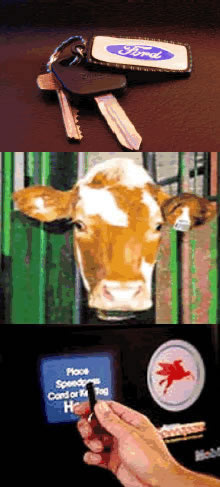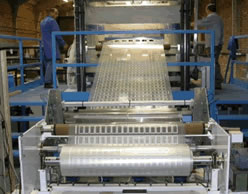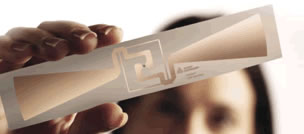Copper Speeds Commerce, Saves Money in RFID Antennas
Copper Applications in Innovative Technology Area
Introduction | How It Works | Retailer Spurs Cost Reductions | Lower-Cost Copper Antenna Technology | An Environmental Question | RFIDs Even Help Make Copper | Notes
Rapidly advancing technologies ensure a role for copper in future RFID (RF identification) systems.
Introduction 
Everyone knows what bar codes are. The zebra-striped images, gummed labels or tags are on just about every item in every store. They prevent pricing errors and speed things up at the checkout counter, so there’s no question that they, or rather, the inventory control system they represent, benefit the consumer. Bar codes are the visible part of the globally accepted Uniform Product Code (UPC) system used to track the movement of goods from manufacture to retail sale. They also track the movement of things like massive international freight containers, checked airline luggage and blood samples, to name just three examples.
At least they do so for now, because bar codes are obsolescent. Useful as they are, the little striped labels have a number of limitations, the most serious of which is that they require line-of-sight visibility in order to be “read” by an optical scanner. Even then, a little dirt can impair their functionality. They often require a human interface, like a supermarket clerk, and they’re limited with respect to the amount of data they can contain. That information is usually the UPC number that identifies the item and its manufacturer. If more information is needed, one or more additional tags are applied. Finally, the tags are entirely “passive,” meaning they can’t provide anything other than static facts about whatever they’re affixed to: identity, date of manufacture, shipping date, destination, etc.
The technology began to change about 25 years ago with the emergence of a new type of tag that can be read using radio-frequency (RF) waves. Because RF penetrates most materials, the new tags don’t require line-of-sight visibility. They are currently used by a few thousand companies worldwide, but they will eventually outnumber their optical counterparts. More than a billion of these RFID (for RF identification) tags or transponders were deployed globally as of mid-2005,1 but that’s just a tiny fraction of what’s to come. Copper, which seems never to be far from new technology, is one of their key ingredients.
How It Works A Typical RFID Tag. The nearly invisible microchip is surrounded by a coiled copper antenna. (Photo - courtesy of Texas Instruments.)
A Typical RFID Tag. The nearly invisible microchip is surrounded by a coiled copper antenna. (Photo - courtesy of Texas Instruments.)Here’s how it works: a typical “passive” RFID tag (the most common type, similar to a bar code label in function) consists of a microchip about the size of a grain of sand connected to a tiny antenna, plus some form of packaging to protect the device and attach it to the product being tagged. The “reader” used to interrogate the RFID emits a signal that inductively couples with the tag’s antenna, momentarily creating enough electrical current to energize the microchip. The chip responds by modulating the reflected RF signal in such a way as to upload its digitally coded information back to the reader, from where it is sent to a computer for processing and storage. The process takes a few milliseconds and can be conducted at distances ranging from a few inches to about 20 feet.
 Common Uses of Low-Frequency RFID Tags: automobile immobilization, livestock identification, retail purchase ID. (Photo - courtesy of Texas Instruments.)
Common Uses of Low-Frequency RFID Tags: automobile immobilization, livestock identification, retail purchase ID. (Photo - courtesy of Texas Instruments.)The maximum useful interrogation distance, or “read range,” depends on a number of factors. Frequency is very important, but so is the antenna and what it’s made from. Copper, which produces the longest read ranges, has been used for RFID antennas from the very start. Early (1980s-vintage) tags operated at relatively low frequencies, 125 kHz to 148 kHz, not far below the long-wave AM radio band. Antennas were made from copper coils, either wound from wire or etched out of foil in much the same way conductors are formed on printed circuit boards (PCBs). These are expensive processes, but they provide RFIDs with a read-range up to several feet.
RFID tags began finding applications in access control, product identification, automobile immobilization and livestock identification; however, they were far too expensive to displace bar codes for uses such as inventory control, even when bought in huge quantities.
Cost is less of a barrier in the case of “active” RFID tags, which can run $50 to $70 apiece or more. Unlike their passive cousins, these devices contain a battery to power the microchip. They also contain sensors to provide stored or real-time information about the tagged object. For example, an active tag might report the temperature history of a carton of hamburgers, or whether there had been an attempt to breach security in a shipping container. NASA is developing active structures capable of logging exposure during space flight. Taking the technology one step farther, the agency’s scientists have developed a hairdryer-sized gun capable of applying thin metal coatings, including copper, on just about anything. Suitably masked, such coatings could easily be made in the form of an RFID antenna.2
The 1990s saw a push toward lower tag costs through development of systems operating at high frequencies (HF), the most common of which being 13.56 MHz. This change offered higher data transfer rates for speedier operation. Tags could be fitted with antennas that were printed onto substrates as a 25- to 35-µm-thick layer of silver-containing conductive ink, a cheaper process than etching copper.3 Costing as little as 20 cents, the tags found applications as mundane as tracking library books and identifying laundry. It appeared for a while that copper’s role in RFIDs would diminish in favor of ink, at least for tags operating at this frequency. On the other hand, the 13.56 MHz frequency itself has some technical limitations, and some industry observers speculated that these shortcomings, coupled with the development of ultra-high frequency (UHF) 915-MHz and microwave frequency 2.45-GHz tags plus improvements in the manufacture of low-frequency 125-kHz tags might relegate the 13.56 MHz spectrum to niche applications. That did not happen; in fact, some major users, including the international shipping firm DHL, are currently committed to the frequency. Meanwhile, 13.56-MHz tags with soldered copper antennas continued to be favored for their unsurpassed reliability.
Retailer Spurs Cost ReductionsUHF tags operating between 868 MHz and 956 MHz gained popularity in the early 2000s; 915 MHz has emerged as the most favored frequency in the spectrum. In addition to their reasonable cost, UHF systems offer the advantage, called “non-collision,” of reading large quantities of tags simultaneously at distances up to 20 ft. Visualize pallet-loads of cartons full of thousands of widgets being read accurately as they pass an interrogation portal at 10 ft per second and you can appreciate the cost-savings such a system enables.
RFID technology, and UHF tags in particular, got a major shot in the arm in June 2003 with the announcement by Wal-Mart that the world’s leading retailer would require its 100 largest suppliers to incorporate RFID technology beginning in January 2005. Wal-Mart used its clout to overcome the RFID industry’s longstanding dilemma: creating a large enough user base to reduce tag prices to the point at which they can be applied to low-cost products. Wal-Mart’s move makes good business sense: by accelerating adoption of RFID, the company might save itself $1.5 to $1.8 billion per year in inventory costs.4 Understandably, several more retailers are now either seriously looking into RFID or have committed to it. The U.S. Department of Defense is helping, too, by issuing guidelines to encourage its suppliers to adopt RFID technology beginning at the end of 2005.
But the cost of individual tags is still the major hurdle standing between passive RFID technology and the volumes enjoyed by bar codes. So-called “chipless” tags might be one emerging solution. These tags contain no microchip, but their antennas, which can be copper, can reflect an RF signal in which (currently) up to 24 data bits can be encoded. That’s far less than the 96-bit minimum contained in a conventional RFID tag, but it might be sufficient to edge out some bar-code applications. Costs of chipless tags are estimated to drop to well less than a cent in large quantities.
Lower-Cost Copper Antenna TechnologyVarious industry sources talk of five-cent RFID tags as the as-yet-unattained Holy Grail. Those numbers likely won’t be gained through sheer volume alone; they will require advances in technology, and copper is, again, a key part of that technology.
 TDAO's RFID Electroplating Line. This pilot line can produce 1 billion tags with copper antennas per year at costs significantly lower than conventional etching processes. (Photo - courtesy of TDAO.)
TDAO's RFID Electroplating Line. This pilot line can produce 1 billion tags with copper antennas per year at costs significantly lower than conventional etching processes. (Photo - courtesy of TDAO.)The United Kingdom-based PCB technology development firm TDAO recently announced a process by which copper antennas can be electrodeposited (plated) precisely onto substrates at extremely high speeds.5 The technology is reportedly cost-competitive with conductive-ink printing while offering denser, higher-conductivity and, therefore, higher quality copper antennas. The company will have the capacity to produce several billion 13.56-MHz HF antennas per year on its prototype 1-meter-wide line by the end of 2005. The company plans to develop higher-capacity equipment in 2006.
The ingenious TDAO process makes use of a very thin (and therefore inexpensive) layer of conductive ink. Too thin for use as an antenna, the ink acts as a target for the electroplated copper, which is deposited from an inexpensive copper sulfate electrolyte. The result: a 100% dense metallic copper antenna that provides all the performance of the etched-foil product but at a fraction of the cost.
A Dutch plating equipment supplier, MECO, offers a similar process, which it claims can reduce the cost of HF antennas by 60% to 75%, and by even more for UHF antennas, which are typically thinner. As with the TDAO process, the final antenna is in the form of fully dense copper.
Qinetiq, another British innovator, offers a somewhat different scheme. In this case, copper is deposited on a thin ink layer by a process known as electroless plating, which is a chemical rather than an electrochemical deposition process. In it, copper plates out only onto areas preprinted with conductive ink. The electroless-plated copper layer is very thin, and a subsequent electroplating step is necessary to bring the antenna to full thickness. The process sounds complex, but MECO claims it produces antennas at about one-half the cost of conventional manufacture. However, the process’ most important feature might be its ability to “grow” copper between the antenna and printed contacts on the microchip, thereby eliminating a separate assembly operation.
 Avery-Dennison's Self-Stick RFID Tag Labels. The tags, shown here, utilize copper antennas and circuitry. (Photo - courtesy of Avery-Dennison.)
Avery-Dennison's Self-Stick RFID Tag Labels. The tags, shown here, utilize copper antennas and circuitry. (Photo - courtesy of Avery-Dennison.)Yet two more British firms, Carclo and Xennia Technology, have teamed up to develop a method to deposit conductive copper inks using an ink-jet printer, while on this side of the pond, Avery-Dennison has developed a high-speed process to apply copper-based RFID tags to self-stick labels.
Given the amount and scope of these development programs, it seems probable that, while the use of first-generation etched copper antennas may be affected by the need to reduce tag prices, lower-cost forms of copper-based antennas will be widely available.
An Environmental Question 
But No Environmental Issues
In fact, there will soon be trillions of RFID tags in use worldwide at any given moment, and most of them will likely be attached to disposable, or, more properly, recyclable cartons, labels or other paper products. That prospect begs the obvious environmental question: “Where will all the copper go?” The answer was recently provided by two organizations that know the situation intimately, and, happily, it is very environmentally friendly.
The Fibre Box Association (FBA), a U.S. trade organization, and the Brussels-based Confederation of European Paper Industries (CEPI) independently studied the fate of “used” RFID tags. FBA, working with the National Council for Air and Stream Improvement, looked at what happens to laminated copper foil antennas and printed silver antennas when the cardboard they’re attached to passes through a pilot-scale paper recycling plant. They found that the copper antennas don’t break down in the re-pulping process, but its not a reason for concern: they’re easily removed early in the paper-making process as a solid waste just like, for example, staples are.
CEPI’s research supports the FBA’s results, and the Confederation additionally cites anecdotal experience from a U.S. paper mill that encounters and successfully removes 50,000 tags per month from its papermaking circuit.6 The copper-containing waste is recycled; as well it should be, since according to CEPI, 100,000 tons of tagged cardboard cartons contain 13.2 tons of copper, if all antennas are made from the metal. The silver in conductive inks tends to pass through the re-pulping process and ends up in the finished paper, but in amounts that are below regulatory thresholds.
RFIDs Even Help Make CopperOne more RFID application deserves mention, if only for its irony. BHP Billiton, based in Australia, is one of the world’s largest copper producers. The company recently faced a problem in one of its electrolytic refineries: damaged stainless steel cathodes (the starter sheets on which pure copper is deposited during the refining process) were found to yield copper of unacceptable quality. As much as 10% of the copper from that one refinery alone might be affected. The problem was one of identifying and tracking the offending stainless sheets. The solution: tag the sheets with encapsulated active RFIDs capable of reporting the status of individual cathodes. BHP tested the solution on 200 tags it placed in service during a six-month, pilot-scale trial and found that the tags could be read with 95% accuracy. Knowing which cathodes were malfunctioning enabled the big copper producer to schedule maintenance efficiently and improve the quality of its product.
Copper helping copper: Why not?
Footnotes:
- Understanding RFID [RFID 101 Workshop - pdf document].

- See this NASA Tech Brief and RFID Journal article for additional information.

- Many low-cost antennas are fabricated from aluminum, but tag performance suffers due to the metal’s lower conductivity compared with copper. Similarly, inks containing carbon or mixtures of carbon and silver have also been developed as a means of reducing costs.

- AMR Research report (Boston, Mass.).

- See this RFID Journal article for additional information.

- See this Industry Week article and CEPI Memo to U.S. Office of Budget and Management for additional information.

Also in this Issue:
- Copper Speeds Commerce, Saves Money in RFID Antennas
